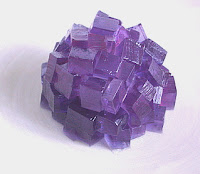Hydrangea macrophylla f. normalis
Hydrangea macrophylla normalis(額紫陽花, Gaku-ajisai) is native to Japan and has flowerheads with subdued and fertile flowers ringed by showy and sterile flowers. Lacecap hydrangeas are thought to be original species of hydrangeas. Gaku means a frame(額縁, gakubuchi). Outer flowers are like a frame.
Mihara-yae(三原八重) is indigenous to Izu-Oshima Island.
Nadeshiko-gakuajisai(撫子額紫陽花) which was found in the east Izu Peninsula has outer flowers with notched petals.
Mikawa-chidori(三河千鳥) is a hedrangea without outer flowers and had been cultivated in a private home in Shizuoka Prefecture.
Sahashi(佐橋) was found at Sahashi in Niigata prefecture.
Sumida-no-hanabi(墨田の花火) is a new variety of gakuajisai. Its flowers represent fireworks at the Sumida River. It's a very popular hydrangea and is planted in my garden.
Hydrangea macrophylla f. macrophylla
Hydrangea macrophylla macrophylla(紫陽花 or 本紫陽花, ajisai or hon-ajisai) is thought to be a type of Hydrangea macrophylla normalis which have mop flowerheads.
Hydrangea macrophylla f. hortensia
European plant cultivators developed Hydrangea macrophylla hortensia based on Japanese hydrangeas.
Hydrangea macrophylla f. domotoi(石化八重紫陽花, Sekka-yae-ajisai) dates back to the Edo Period. Its stem is flat. It is also known as "Juni-hitoe" which refers to lady's ceremonial court dress.
Hydrangea macrophylla f. concavosepala(Ayesha bigleaf hydrangea, Popcorn hydrangea)
Hydrangea macrophylla concavosepala or Hydrangea macrophylla cv. Uzu-azisai (渦紫陽花, uzu-ajisai) dates back to the Edo Period.
Hydrangea macrophylla f. variegate
Hydrangea macrophylla f. variegate(Gakuajisai with variegated leaves) is one of antique-variety hydrangeas and was already known in the Edo Period.
Hydrangea serrata (H. macrophylla subsp. serrata)
Hydrangea serrata(山紫陽花, yama-ajisai) is a variety of hydrangea native to mountainous regions of eastern Asia and Japan.
Compared to Hydrangea macrophylla, Hydrangea serrata are small and its leaves are small, thin and lusterless. They are firm favorites with some gardening lovers. I like them.
Hydrangea serrata f. rosalba(紅額, benigaku)
Hydrangea serrata f. prolifera(七段花, Shichidanka)
Hydrangea serrata f. pulchella
(清澄沢紫陽花, Kiyosumisawa-ajisai) is found around Mt. Kiyosumi in Chiba Prefecture.
Amacha(甘茶) means sweet tea.Hydrangea is a poisonous plant, but a herbal tea made from amacha's leaves containing a natural sweetener named pyllodulcin are used for Buddha's birthday Festival on April 8th. The tea is poured over a statue of Buddha and is served at the festival.
Hydrangea serrata var. megacarpa(subsp. Yezoenis)
Hydrangea serrata var. megacarpa(蝦夷紫陽花, Ezo-ajisai) grow mainly in areas of heavy snowfall in Japan.
Rokkoyaetemari(六甲八重手毬) was found on the Mt. Rokko in Kobe.
Hydrangea serrata' "Akisinotemari"(秋篠手毬) was found on 29 June 1990 when Prince Akishino and Princess Kiko got married.
Hydrangea hirta(小紫陽花, koajisai) is a hedrangea without outer flowers.
Oakleaf hydrangea(柏葉紫陽花)
Hydrangea quercifolia(Oakleaf hydrangea) is native to the Southeastern United States. Recently, I often see these hydrangeas in my area.
Hydrangea and snail go together.


額紫陽花袋 デザイン/藤本正子
"drawstring pouch in the shape of Hydrangea macrophylla forma normalis " designed by Masako Fujimoto
Shigeyoshi Inoue ed.,Wa-no-Nunoasobi-chirimenzaiku,(Tokyo:ONdori Sha,2003),P.4
井上重義監修,和の布遊びちりめん細工,雄鶏社,2003,P.4
A confection representing hydrangea. White bean-paste ball is coated with colored kanten cubes.
color gradations with kanten cubes









































